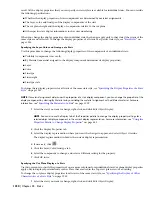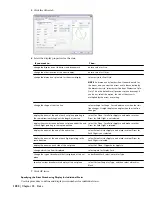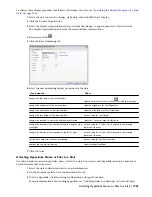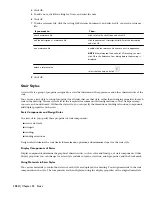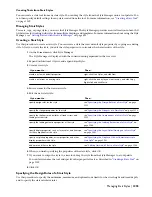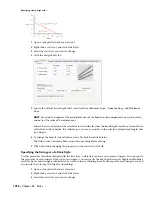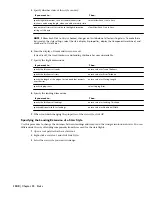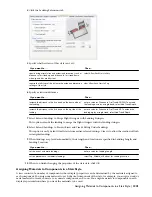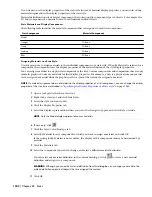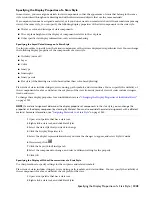
Viewing an overlapping stair condition
7
On the Format menu, click Display Manager.
8
Expand Sets, select the current (bold) display set.
9
Click the Display Representation Control tab. Scroll to the Stair object.
10
Turn on Plan Overlapping in addition to the current display representation, and click OK.
11
For this example, we will display all components of the stair above the overlap section outlined in red.
Select the stair, right-click, and click Edit Object Display.
12
Click the Display Properties tab.
13
Click Object Override for Plan, Plan Low Detail, or Plan High Detail (whichever is displayed in the current
display set). Select all the components, turn off visibility, and click OK.
14
Click Object Override for Plan Overlapping. Select the desired components and turn on visibility. For this
example, turn on visibility for Riser up, Nosing up, Path up, Outline up, Riser down, Nosing down, Path
down, Outline down, Riser down (above overlap), Nosing down (above overlap), Path down (above overlap),
Outline down (above overlap), Riser down (below overlap), Nosing down (below overlap), Path down
(below overlap), and Outline down (below overlap).
15
Select Riser down (above overlap), Nosing down (above overlap), Path down (above overlap), and Outline
down (above overlap). Select any of the colors from the selected components; then select red in the Select
Color dialog box, and click OK twice.
NOTE If the stair style includes stringers, they should be added to the set of components.
16
Click OK twice.
Applying Tool Properties to an Existing Stair
Use this procedure to apply the properties of a stair tool to one or more existing stairs. The properties include the stair
style and any other settings specified in the tool you select.
1
Open the tool palette that you want to use.
If necessary, scroll to display the tool that you want to use.
2
Right-click a stair tool, and click Apply Tool Properties to Stair.
3
Select the stairs, and press
ENTER
.
4
Edit the properties of the stairs in the Properties palette, if necessary.
NOTE Some tool properties cannot be applied to existing stairs. For example, stair shape and turn type do not change. In
addition, some properties may be incompatible with existing stairs. For example, a stair that has a vertical orientation of Down
cannot terminate with a landing.
Changing the Location of a Stair
Use this procedure to relocate a stair by changing the coordinate values of its insertion point. The stair also has an
orientation with respect to the WCS or the current UCS. For example, if the top and bottom of the stair are parallel to
the XY plane, its normal is parallel to the Z axis. You can change the orientation of the stair by aligning its normal
with another axis. You can also rotate the stair on its plane by changing the rotation angle.
1228 | Chapter 25 Stairs
Summary of Contents for 00128-051462-9310 - AUTOCAD 2008 COMM UPG FRM 2005 DVD
Page 1: ...AutoCAD Architecture 2008 User s Guide 2007 ...
Page 4: ...1 2 3 4 5 6 7 8 9 10 ...
Page 40: ...xl Contents ...
Page 41: ...Workflow and User Interface 1 1 ...
Page 42: ...2 Chapter 1 Workflow and User Interface ...
Page 146: ...106 Chapter 3 Content Browser ...
Page 164: ...124 Chapter 4 Creating and Saving Drawings ...
Page 370: ...330 Chapter 6 Drawing Management ...
Page 440: ...400 Chapter 8 Drawing Compare ...
Page 528: ...488 Chapter 10 Display System ...
Page 540: ...500 Chapter 11 Style Manager ...
Page 612: ...572 Chapter 13 Content Creation Guidelines ...
Page 613: ...Conceptual Design 2 573 ...
Page 614: ...574 Chapter 14 Conceptual Design ...
Page 678: ...638 Chapter 16 ObjectViewer ...
Page 683: ...Designing with Architectural Objects 3 643 ...
Page 684: ...644 Chapter 18 Designing with Architectural Objects ...
Page 788: ...748 Chapter 18 Walls ...
Page 942: ...902 Chapter 19 Curtain Walls ...
Page 1042: ...1002 Chapter 21 AEC Polygons ...
Page 1052: ...Changing a door width 1012 Chapter 22 Doors ...
Page 1106: ...Changing a window width 1066 Chapter 23 Windows ...
Page 1172: ...1132 Chapter 24 Openings ...
Page 1226: ...Using grips to change the flight width of a spiral stair run 1186 Chapter 25 Stairs ...
Page 1368: ...Using the Angle grip to edit slab slope 1328 Chapter 28 Slabs and Roof Slabs ...
Page 1491: ...Design Utilities 4 1451 ...
Page 1492: ...1452 Chapter 30 Design Utilities ...
Page 1536: ...1496 Chapter 31 Layout Curves and Grids ...
Page 1564: ...1524 Chapter 32 Grids ...
Page 1611: ...Documentation 5 1571 ...
Page 1612: ...1572 Chapter 36 Documentation ...
Page 1706: ...Stretching a surface opening Moving a surface opening 1666 Chapter 36 Spaces ...
Page 1710: ...Offsetting the edge of a window opening on a freeform space surface 1670 Chapter 36 Spaces ...
Page 1956: ...1916 Chapter 42 Fields ...
Page 2035: ...Properties of a detail callout The Properties of a Callout Tool 1995 ...
Page 2060: ...2020 Chapter 45 Callouts ...
Page 2170: ...2130 Chapter 47 AEC Content and DesignCenter ...
Page 2171: ...Other Utilities 6 2131 ...
Page 2172: ...2132 Chapter 48 Other Utilities ...
Page 2182: ...2142 Chapter 51 Reference AEC Objects ...
Page 2212: ...2172 Chapter 52 Customizing and Adding New Content for Detail Components ...
Page 2217: ...AutoCAD Architecture 2008 Menus 54 2177 ...
Page 2226: ...2186 Chapter 54 AutoCAD Architecture 2008 Menus ...
Page 2268: ...2228 Index ...

















